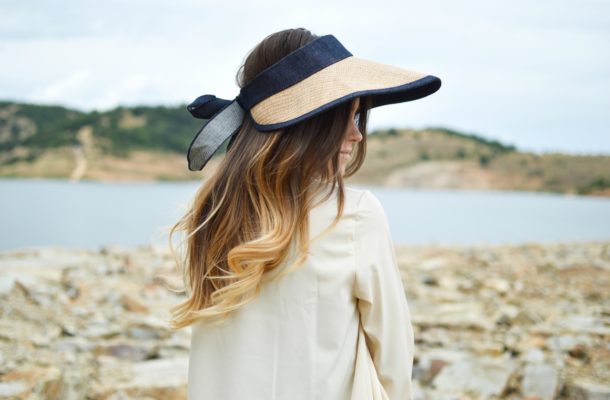6 natural ways to protect your skin from the sun

The summer might be over in the land down under – despite the recent sweltering temperatures – but it’s drawing ever closer in other parts of the world. No matter if you’re planning a romantic getaway somewhere in the south of France, or an amazing adventure with friends on the shores of Ibiza, it’s always good to be prepared for sunny days and hot weather.
You must always protect your skin from the sun and people who prefer natural rather than commercial solutions can still take effective measures to prevent the sunburn, wrinkles and skin cancer which can be caused by long term or extreme sun exposure. Here are six natural ways you can protect your skin from the sun all year round.
Sombrero, anyone?
Starting with the simplest solution you can implement into your daily routine, wearing a wide-brimmed hat can protect your face from harmful UV rays and safeguard your complexion from wrinkles and premature aging while elevating your personal style.
However, not all hats were created equal, and although a straw sunhat looks great, you might want to avoid wearing it because it can let sunlight through the small holes in the brim. Wearing a solid-brim had is especially important if you find yourself out and about and have forgotten to apply sunscreen.
Follow the shade
Wherever you go, follow the shade. This is the best way to limit sun exposure to a healthy amount, and given the fact that most cafés, restaurants and other outdoor areas have large shade sails, you can hop from one shade to another wherever you go, rather than roasting out in the sun.
Consider limiting your sun exposure, especially when you’re having a drink with your friends outside, to no more than 15 minutes before you seek the shade again and give your skin some respite.
Use natural sunscreen
Homemade alternatives to commercial sunscreen can protect your skin safely and naturally if mixed properly and applied regularly in conjunction with wearing a hat and shirt and staying in the shade where possible. Remember though that ultra-violet radiation can damage skin even on cloudy days. Just because you can’t feel the sun on your skin doesn’t mean it can’t burn you.
You want to choose natural oils and ingredients that have a significant SPF (sun protection factor). Additional ingredients which merely offer an attractive color or aroma won’t protect your skin from the sun.
While it may be difficult to find, for example, raspberry oil has an impressive SPF of 30 – 50 and contains vitamins A and E which helps keep skin young. It doesn’t smell like raspberries though, which is why it’s often mixed with other ingredients for application to the skin. Almond oil has a natural SPF of 5 – meaning you can spend 5 times as long outside before burning when protected by it.
Coconut oil, zinc oxide, carrot seed oil, and Shea butter can all be added to the mix, but it’s vital that any homemade sunscreen has enough ingredients with a proven SPF to protect you properly.
Wear the right clothes
When it comes to protecting your skin from unwanted sun exposure, one of the best things you can do is to wear clothes that cover your body and arms. While this effective solution isn’t always practical on the beach, wearing baggy, breathable clothes that don’t stick to the skin can still allow you to enjoy the summer breeze without the fear of sunburn.
Nutrition can play a big role
It might not be your first guess, but your diet can influence your body’s ability to protect itself from the harmful effects of sun exposure. By simply sticking to a healthy diet plan and taking in plenty of vitamin rich foods, you can help your skin stay healthy all year round.
While this should certainly not be your only method of protecting yourself from excess sunlight, you can only do yourself good by sticking to healthy greens and all kinds of colourful fruits and vegetables. Consuming the carotenoids found in fruits and veggies will help increase your ability to fight off the effects of harmful rays.
Choose carefully when to venture outside
Finally, it’s always a prudent and wise idea to limit your sun exposure by simply staying indoors until the sun is lower in the sky and the heat drops down by a few degrees.
You can either make the most out of your day by getting out and about early in the morning or wait to take your stroll along the beach or promenade after 5PM. If you must be outside during the heat of the day, hunt for shade between 10AM and 3PM when the sunlight is strongest.
Sun exposure is healthy for you in the right amount – it supplies your body with essential vitamin D, and getting outside boosts your mood and mental clarity. However, as we all know, too much sunlight can have an adverse effect on your health and well-being.
Wanting to use natural products doesn’t mean the sun can be ignored. It means you have to take more care of yourself, rather than less, so be sure to follow these simple steps in order to effectively regulate your sun exposure for a healthy and vibrant lifestyle.
Derek Lotts is an experienced freelance writer and researcher. His main areas of interest are small business, home improvement, and sustainable living. He strongly believes in the power of sharing knowledge and ideas through the mediums of modern technology.













Alan Stevenson
April 19, 2018 at 12:22 pm
A search of the internet for formulae for natural sunscreens comes up with a wide variety of offerings (mostly ads) but little scientific data to back them up. How about sharing some of your methods? Please?
Amelia
April 19, 2018 at 7:24 pm
It’s nonsense isn’t it? Why would people risk the very real threat of skin cancer, which absolutely can disfigure and kill you, because of some nameless threat from proper sun cream. There’s no epidemic of suncream sufferers hitting the doctors, just people who didn’t use it in their youth and are paying for it now.
Does the ‘natural only’ brigade eschew modernity in other facets too? Do they live in caves and try to carve smartphones out of rocks? There’s some good advice in this article – wear a hat and a shirt and stay in the shade – but for heaven’s sake slap on the factor 50 if you don’t want to end up looking like you were on the night shift at Chernobyl.